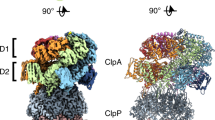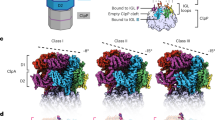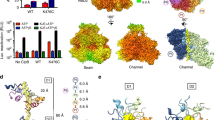Abstract
The hexameric AAA+ ring of Escherichia coli ClpX, an ATP-dependent machine for protein unfolding and translocation, functions with the ClpP peptidase to degrade target substrates. For efficient function, ClpX subunits must switch between nucleotide-loadable (L) and nucleotide-unloadable (U) conformations, but the roles of switching are uncertain. Moreover, it is controversial whether working AAA+-ring enzymes assume symmetric or asymmetric conformations. Here, we show that a covalent ClpX ring with one subunit locked in the U conformation catalyzes robust ATP hydrolysis, with each unlocked subunit able to bind and hydrolyze ATP, albeit with highly asymmetric position-specific affinities. Preventing U↔L interconversion in one subunit alters the cooperativity of ATP hydrolysis and reduces the efficiency of substrate binding, unfolding and degradation, showing that conformational switching enhances multiple aspects of wild-type ClpX function. These results support an asymmetric and probabilistic model of AAA+-ring activity.
This is a preview of subscription content, access via your institution
Access options
Subscribe to this journal
Receive 12 print issues and online access
$189.00 per year
only $15.75 per issue
Buy this article
- Purchase on Springer Link
- Instant access to full article PDF
Prices may be subject to local taxes which are calculated during checkout






Similar content being viewed by others
Accession codes
References
Baker, T.A. & Sauer, R.T. ClpXP, an ATP-powered unfolding and protein-degradation machine. Biochim. Biophys. Acta 1823, 15–28 (2012).
Hersch, G.L., Burton, R.E., Bolon, D.N., Baker, T.A. & Sauer, R.T. Asymmetric interactions of ATP with the AAA+ ClpX6 unfoldase: allosteric control of a protein machine. Cell 121, 1017–1027 (2005).
Stinson, B.M. et al. Nucleotide binding and conformational switching in the hexameric ring of a AAA+ machine. Cell 153, 628–639 (2013).
Glynn, S.E., Martin, A., Nager, A.R., Baker, T.A. & Sauer, R.T. Structures of asymmetric ClpX hexamers reveal nucleotide-dependent motions in a AAA+ protein-unfolding machine. Cell 139, 744–756 (2009).
Smith, D.M., Fraga, H., Reis, C., Kafri, G. & Goldberg, A.L. ATP binds to proteasomal ATPases in pairs with distinct functional effects, implying an ordered reaction cycle. Cell 144, 526–538 (2011).
Sauer, R.T. & Baker, T.A. AAA+ proteases: ATP-fueled machines of protein destruction. Annu. Rev. Biochem. 80, 587–612 (2011).
Martin, A., Baker, T.A. & Sauer, R.T. Rebuilt AAA+ motors reveal operating principles for ATP-fuelled machines. Nature 437, 1115–1120 (2005).
Wojtyra, U.A., Thibault, G., Tuite, A. & Houry, W.A. The N-terminal zinc binding domain of ClpX is a dimerization domain that modulates the chaperone function. J. Biol. Chem. 278, 48981–48990 (2003).
Popp, M.W., Antos, J.M., Grotenbreg, G.M., Spooner, E. & Ploegh, H.L. Sortagging: a versatile method for protein labeling. Nat. Chem. Biol. 3, 707–708 (2007).
Kim, Y.I. et al. Molecular determinants of complex formation between Clp/Hsp100 ATPases and the ClpP peptidase. Nat. Struct. Biol. 8, 230–233 (2001).
Joshi, S.A., Hersch, G.L., Baker, T.A. & Sauer, R.T. Communication between ClpX and ClpP during substrate processing and degradation. Nat. Struct. Mol. Biol. 11, 404–411 (2004).
Kenniston, J.A., Baker, T.A., Fernandez, J.M. & Sauer, R.T. Linkage between ATP consumption and mechanical unfolding during the protein processing reactions of an AAA+ degradation machine. Cell 114, 511–520 (2003).
Taraska, J.W., Puljung, M.C., Olivier, N.B., Flynn, G.E. & Zagotta, W.N. Mapping the structure and conformational movements of proteins with transition metal ion FRET. Nat. Methods 6, 532–537 (2009).
Burton, R.E., Baker, T.A. & Sauer, R.T. Energy-dependent degradation: linkage between ClpX-catalyzed nucleotide hydrolysis and protein-substrate processing. Protein Sci. 12, 893–902 (2003).
Cordova, J.C. et al. Stochastic but highly coordinated protein unfolding and translocation by the ClpXP proteolytic machine. Cell 158, 647–658 (2014).
Aubin-Tam, M.-E., Olivares, A.O., Sauer, R.T., Baker, T.A. & Lang, M.J. Single-molecule protein unfolding and translocation by an ATP-fueled proteolytic machine. Cell 145, 257–267 (2011).
Sen, M. et al. The ClpXP protease unfolds substrates using a constant rate of pulling but different gears. Cell 155, 636–646 (2013).
Maillard, R.A. et al. ClpX(P) generates mechanical force to unfold and translocate its protein substrates. Cell 145, 459–469 (2011).
Kenniston, J.A., Baker, T.A. & Sauer, R.T. Partitioning between unfolding and release of native domains during ClpXP degradation determines substrate selectivity and partial processing. Proc. Natl. Acad. Sci. USA 102, 1390–1395 (2005).
Thibault, G. & Houry, W.A. Role of the N-terminal domain of the chaperone ClpX in the recognition and degradation of lambda phage protein O. J. Phys. Chem. B 116, 6717–6724 (2012).
Lander, G.C. et al. Complete subunit architecture of the proteasome regulatory particle. Nature 482, 186–191 (2012).
Matyskiela, M.E., Lander, G.C. & Martin, A. Conformational switching of the 26S proteasome enables substrate degradation. Nat. Struct. Mol. Biol. 20, 781–788 (2013).
Beckwith, R., Estrin, E., Worden, E.J. & Martin, A. Reconstitution of the 26S proteasome reveals functional asymmetries in its AAA+ unfoldase. Nat. Struct. Mol. Biol. 20, 1164–1172 (2013).
Chen, I., Dorr, B.M. & Liu, D.R. A general strategy for the evolution of bond-forming enzymes using yeast display. Proc. Natl. Acad. Sci. USA 108, 11399–11404 (2011).
Kim, Y.I., Burton, R.E., Burton, B.M., Sauer, R.T. & Baker, T.A. Dynamics of substrate denaturation and translocation by the ClpXP degradation machine. Mol. Cell 5, 639–648 (2000).
Nørby, J.G. Coupled assay of Na+,K+-ATPase activity. Methods Enzymol. 156, 116–119 (1988).
Geladopoulos, T.P., Sotiroudis, T.G. & Evangelopoulos, A.E. A malachite green colorimetric assay for protein phosphatase activity. Anal. Biochem. 192, 112–116 (1991).
Lavinder, J.J., Hari, S.B., Sullivan, B.J. & Magliery, T.J. High-throughput thermal scanning: a general, rapid dye-binding thermal shift screen for protein engineering. J. Am. Chem. Soc. 131, 3794–3795 (2009).
Acknowledgements
This research was supported by the US National institutes of Health grant GM-101988 (R.T.S.). B.M.S. was supported by a Massachusetts Institute of Technology Poitras predoctoral fellowship. T.A.B. is supported as an employee of the Howard Hughes Medical Institute.
Author information
Authors and Affiliations
Contributions
B.M.S., V.B. and K.R.S. designed experiments. B.M.S. performed experiments. B.M.S., T.A.B. and R.T.S. analyzed data and wrote the manuscript. All authors approved the final version of the manuscript.
Corresponding author
Ethics declarations
Competing interests
The authors declare no competing financial interests.
Supplementary information
Supplementary Data Set 1
SDS-PAGE gel shown in Figure 1e (PDF 901 kb)
Rights and permissions
About this article
Cite this article
Stinson, B., Baytshtok, V., Schmitz, K. et al. Subunit asymmetry and roles of conformational switching in the hexameric AAA+ ring of ClpX. Nat Struct Mol Biol 22, 411–416 (2015). https://doi.org/10.1038/nsmb.3012
Received:
Accepted:
Published:
Issue Date:
DOI: https://doi.org/10.1038/nsmb.3012
This article is cited by
-
Extreme parsimony in ATP consumption by 20S complexes in the global disassembly of single SNARE complexes
Nature Communications (2021)
-
Engineering subtilisin proteases that specifically degrade active RAS
Communications Biology (2021)
-
Translation of the long-term fundamental studies on viral DNA packaging motors into nanotechnology and nanomedicine
Science China Life Sciences (2020)
-
Assessing heterogeneity in oligomeric AAA+ machines
Cellular and Molecular Life Sciences (2017)
-
Role of the D1-D2 Linker of Human VCP/p97 in the Asymmetry and ATPase Activity of the D1-domain
Scientific Reports (2016)



